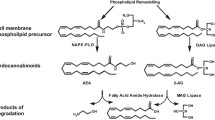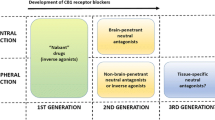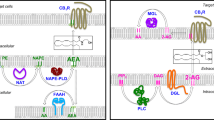Abstract
Endocannabinoids (ECs) are small lipid mediators that play a critical role in energy metabolism. Human studies have shown that the EC tone in peripheral tissues positively correlates with increased adiposity. Furthermore, pharmacological inhibition of EC signaling results in weight loss in humans. However, the mechanisms that cause the dysregulation of the EC system in obesity are not well-understood. Since the clinical utility of currently available EC blockers is severely limited due to their side effects like depression and suicidal ideation that are caused by central effects, it is important to delineate the role of central and peripheral effects of EC signaling in regulating glucose and lipid metabolism.

Similar content being viewed by others
Abbreviations
- 2-AG:
-
2-arachidonoylglycerol
- ACC:
-
acetyl-CoA carboxylase
- AEA:
-
anandamide
- CNS:
-
central nervous system
- DM2:
-
type 2 diabetes mellitus
- ECs:
-
endocannabinoids
- FAAH:
-
fatty acid amide hydrolase
- FAS:
-
fatty acid synthase
- GLUT4:
-
glucose transporter 4
- HSL:
-
hormone-sensitive lipase
- ICV:
-
intracerebroventricular
- KO:
-
knock-out
- LCB1:
-
hepatocyte-specific CB1 receptor knock-out
- LPL:
-
lipoprotein lipase
- MBH:
-
mediobasal hypothalamus
- NE:
-
norepinephrine
- Pepck:
-
phosphoenolpyruvate kinase
- PPARγ:
-
peroxisome proliferator-activated receptor γ
- Srebp1c:
-
sterol regulatory element-binding protein-1c
- UCP2:
-
uncoupling protein 2
- WAT:
-
white adipose tissue
References
Pacher P, Batkai S, Kunos G (2006) The endocannabinoid system as an emerging target of pharmacotherapy. Pharmacol Rev 58:389–462. 58/3/389 [pii]. doi:10.1124/pr.58.3.2
Starowicz KM, Cristino L, Matias I, Capasso R, Racioppi A, Izzo AA, Di Marzo V (2008) Endocannabinoid dysregulation in the pancreas and adipose tissue of mice fed with a high-fat diet. Obesity (Silver Spring) 16:553–565. oby2007106 [pii]. doi:10.1038/oby.2007.106
Roche R, Hoareau L, Bes-Houtmann S, Gonthier MP, Laborde C, Baron JF, Haffaf Y, Cesari M, Festy F (2006) Presence of the cannabinoid receptors, CB1 and CB2, in human omental and subcutaneous adipocytes. Histochem Cell Biol 126:177–187. doi:10.1007/s00418-005-0127-4
Di Marzo V, Goparaju SK, Wang L, Liu J, Batkai S, Jarai Z, Fezza F, Miura GI, Palmiter RD, Sugiura T, Kunos G (2001) Leptin-regulated endocannabinoids are involved in maintaining food intake. Nature 410:822–825
Williams CM, Kirkham TC (1999) Anandamide induces overeating: mediation by central cannabinoid (CB1) receptors. Psychopharmacology (Berl) 143:315–317
Weigle DS, Bukowski TR, Foster DC, Holderman S, Kramer JM, Lasser G, Lofton-Day CE, Prunkard DE, Raymond C, Kuijper JL (1995) Recombinant ob protein reduces feeding and body weight in the ob/ob mouse. J Clin Invest 96:2065–2070
Halaas JL, Gajiwala KS, Maffei M, Cohen SL, Chait BT, Rabinowitz D, Lallone RL, Burley SK, Friedman JM (1995) Weight-reducing effects of the plasma protein encoded by the obese gene. Science 269:543–546
Pelleymounter MA, Cullen MJ, Baker MB, Hecht R, Winters D, Boone T, Collins F (1995) Effects of the obese gene product on body weight regulation in ob/ob mice. Science 269:540–543
Matias I, Gonthier MP, Orlando P, Martiadis V, De Petrocellis L, Cervino C, Petrosino S, Hoareau L, Festy F, Pasquali R, Roche R, Maj M, Pagotto U, Monteleone P, Di MV (2006) Regulation, function, and dysregulation of endocannabinoids in models of adipose and beta-pancreatic cells and in obesity and hyperglycemia. J Clin Endocrinol Metab 91:3171–3180
Osei-Hyiaman D, DePetrillo M, Pacher P, Liu J, Radaeva S, Batkai S, Harvey-White J, Mackie K, Offertaler L, Wang L, Kunos G (2005) Endocannabinoid activation at hepatic CB1 receptors stimulates fatty acid synthesis and contributes to diet-induced obesity. J Clin Invest 115:1298–1305
Ravinet Trillou C, Arnone M, Delgorge C, Gonalons N, Keane P, Maffrand JP, Soubrie P (2003) Anti-obesity effect of SR141716, a CB1 receptor antagonist, in diet-induced obese mice. Am J Physiol Regul Integr Comp Physiol 284:R345–353. 00545.2002 [pii]. doi:10.1152/ajpregu.00545.2002
Poirier B, Bidouard JP, Cadrouvele C, Marniquet X, Staels B, O’Connor SE, Janiak P, Herbert JM (2005) The anti-obesity effect of rimonabant is associated with an improved serum lipid profile. Diabetes Obes Metab 7:65–72. DOM374 [pii]. doi:10.1111/j.1463-1326.2004.00374.x
Ravinet Trillou C, Delgorge C, Menet C, Arnone M, Soubrie P (2004) CB1 cannabinoid receptor knockout in mice leads to leanness, resistance to diet-induced obesity and enhanced leptin sensitivity. Int J Obes Relat Metab Disord 28:640–648. 0802583 [pii]. doi:10.1038/sj.ijo.0802583
Cota D, Marsicano G, Tschop M, Grubler Y, Flachskamm C, Schubert M, Auer D, Yassouridis A, Thone-Reineke C, Ortmann S, Tomassoni F, Cervino C, Nisoli E, Linthorst ACE, Pasquali R, Lutz B, Stalla GK, Pagotto U (2003) The endogenous cannabinoid system affects energy balance via central orexigenic drive and peripheral lipogenesis. J Clin Invest 112:423–431
Pi-Sunyer FX, Aronne LJ, Heshmati HM, Devin J, Rosenstock J (2006) Effect of rimonabant, a cannabinoid-1 receptor blocker, on weight and cardiometabolic risk factors in overweight or obese patients: RIO-North America: a randomized controlled trial. JAMA 295:761–775
Van Gaal LF, Rissanen AM, Scheen AJ, Ziegler O, Rossner S (2005) Effects of the cannabinoid-1 receptor blocker rimonabant on weight reduction and cardiovascular risk factors in overweight patients: 1-year experience from the RIO-Europe study. Lancet 365:1389–1397. S0140-6736(05) 66374-X [pii]. doi:10.1016/S0140-6736(05)66374-X
Despres JP, Golay A, Sjostrom L (2005) Effects of rimonabant on metabolic risk factors in overweight patients with dyslipidemia. N Engl J Med 353:2121–2134
Liu YL, Connoley IP, Wilson CA, Stock MJ (2005) Effects of the cannabinoid CB1 receptor antagonist SR141716 on oxygen consumption and soleus muscle glucose uptake in Lep(ob)/Lep(ob) mice. Int J Obes (Lond) 29:183–187. 0802847 [pii]. doi:10.1038/sj.ijo.0802847
Osei-Hyiaman D, Liu J, Zhou L, Godlewski G, Harvey-White J, Jeong WI, Batkai S, Marsicano G, Lutz B, Buettner C, Kunos G (2008) Hepatic CB1 receptor is required for development of diet-induced steatosis, dyslipidemia, and insulin and leptin resistance in mice. J Clin Invest 118:3160–3169. doi:10.1172/JCI34827
Bellocchio L, Cervino C, Vicennati V, Pasquali R, Pagotto U (2008) Cannabinoid type 1 receptor: another arrow in the adipocytes’ bow. J Neuroendocrinol 20(Suppl 1):130–138. JNE1682 [pii]. doi:10.1111/j.1365-2826.2008.01682.x
Bensaid M, Gary-Bobo M, Esclangon A, Maffrand JP, Le Fur G, Oury-Donat F, Soubrie P (2003) The cannabinoid CB1 receptor antagonist SR141716 increases Acrp30 mRNA expression in adipose tissue of obese fa/fa rats and in cultured adipocyte cells. Mol Pharmacol 63:908–914
Engeli S, Bohnke J, Feldpausch M, Gorzelniak K, Janke J, Batkai S, Pacher P, Harvey-White J, Luft FC, Sharma AM, Jordan J (2005) Activation of the peripheral endocannabinoid system in human obesity. Diabetes 54:2838–2843
Cote M, Matias I, Lemieux I, Petrosino S, Almeras N, Despres JP, Di Marzo V (2007) Circulating endocannabinoid levels, abdominal adiposity and related cardiometabolic risk factors in obese men. Int J Obes (Lond) 31:692–699. 0803539 [pii]. doi:10.1038/sj.ijo.0803539
Bluher M, Engeli S, Kloting N, Berndt J, Fasshauer M, Batkai S, Pacher P, Schon MR, Jordan J, Stumvoll M (2006) Dysregulation of the peripheral and adipose tissue endocannabinoid system in human abdominal obesity. Diabetes 55:3053–3060
Di Marzo V, Cote M, Matias I, Lemieux I, Arsenault BJ, Cartier A, Piscitelli F, Petrosino S, Almeras N, Despres JP (2009) Changes in plasma endocannabinoid levels in viscerally obese men following a 1 year lifestyle modification programme and waist circumference reduction: associations with changes in metabolic risk factors. Diabetologia 52:213–217. doi:10.1007/s00125-008-1178-6
Gonthier MP, Hoareau L, Festy F, Matias I, Valenti M, Bes-Houtmann S, Rouch C, Robert-Da Silva C, Chesne S, Lefebvre d’Hellencourt C, Cesari M, Di Marzo V, Roche R (2007) Identification of endocannabinoids and related compounds in human fat cells. Obesity 15:837–845
Di Marzo V, De Petrocellis L, Sepe N, Buono A (1996) Biosynthesis of anandamide and related acylethanolamides in mouse J774 macrophages and N18 neuroblastoma cells. Biochem J 316(Pt 3):977–984
Varga K, Wagner JA, Bridgen DT, Kunos G (1998) Platelet- and macrophage-derived endogenous cannabinoids are involved in endotoxin-induced hypotension. FASEB J 12:1035–1044
Matias I, Petrosino S, Racioppi A, Capasso R, Izzo AA, Di Marzo V (2008) Dysregulation of peripheral endocannabinoid levels in hyperglycemia and obesity: effect of high fat diets. Mol Cell Endocrinol 286:S66–78. S0303-7207(08) 00060-9 [pii]. doi:10.1016/j.mce.2008.01.026
Berger A, Crozier G, Bisogno T, Cavaliere P, Innis S, Di Marzo V (2001) Anandamide and diet: inclusion of dietary arachidonate and docosahexaenoate leads to increased brain levels of the corresponding N-acylethanolamines in piglets. Proc Natl Acad Sci U S A 98:6402–6406. 101119098 [pii]. doi:10.1073/pnas.101119098
Malcher-Lopes R, Di S, Marcheselli VS, Weng FJ, Stuart CT, Bazan NG, Tasker JG (2006) Opposing crosstalk between leptin and glucocorticoids rapidly modulates synaptic excitation via endocannabinoid release. J Neurosci 26:6643–6650. 26/24/6643 [pii]. doi:10.1523/JNEUROSCI.5126-05.2006
D’Eon TM, Pierce KA, Roix JJ, Tyler A, Chen H, Teixeira SR (2008) The role of adipocyte insulin resistance in the pathogenesis of obesity-related elevations in endocannabinoids. Diabetes 57:1262–1268
Murdolo G, Kempf K, Hammarstedt A, Herder C, Smith U, Jansson PA (2007) Insulin differentially modulates the peripheral endocannabinoid system in human subcutaneous abdominal adipose tissue from lean and obese individuals. J Endocrinol Invest 30:RC17–RC21. doi:3973 [pii]
Bartness TJ, Kay Song C, Shi H, Bowers RR, Foster MT (2005) Brain-adipose tissue cross talk. Proc Nutr Soc 64:53–64. doi:S002966510500008X [pii]
Buettner C, Camacho RC (2008) Hypothalamic control of hepatic glucose production and its potential role in insulin resistance. Endocrinol Metab Clin North Am 37:825–840. S0889-8529(08) 00060-1 [pii]. doi:10.1016/j.ecl.2008.09.001
Shimabukuro M, Koyama K, Chen G, Wang MY, Trieu F, Lee Y, Newgard CB, Unger RH (1997) Direct antidiabetic effect of leptin through triglyceride depletion of tissues. Proc Natl Acad Sci USA 94:4637–4641
Wang ZW, Zhou YT, Lee Y, Higa M, Kalra SP, Unger RH (1999) Hyperleptinemia depletes fat from denervated fat tissue. Biochem Biophys Res Commun 260:653–657
Buettner C, Muse ED, Cheng A, Chen L, Scherer T, Pocai A, Su K, Cheng B, Li X, Harvey-White J, Schwartz GJ, Kunos G, Rossetti L (2008) Leptin controls adipose tissue lipogenesis via central, STAT3-independent mechanisms. Nat Med 14:667–675
Addy C, Wright H, Van Laere K, Gantz I, Erondu N, Musser BJ, Lu K, Yuan J, Sanabria-Bohorquez SM, Stoch A, Stevens C, Fong TM, De Lepeleire I, Cilissen C, Cote J, Rosko K, Gendrano IN 3rd, Nguyen AM, Gumbiner B, Rothenberg P, de Hoon J, Bormans G, Depre M, Eng WS, Ravussin E, Klein S, Blundell J, Herman GA, Burns HD, Hargreaves RJ, Wagner J, Gottesdiener K, Amatruda JM, Heymsfield SB (2008) The acyclic CB1R inverse agonist taranabant mediates weight loss by increasing energy expenditure and decreasing caloric intake. Cell Metab 7:68–78. S1550-4131(07) 00367-1 [pii]. doi:10.1016/j.cmet.2007.11.012
Motaghedi R, McGraw TE (2008) The CB1 Endocannabinoid system modulates adipocyte insulin sensitivity. Obesity 16:1727–1734
Pagano C, Pilon C, Calcagno A, Urbanet R, Rossato M, Milan G, Bianchi K, Rizzuto R, Bernante P, Federspil G, Vettor R (2007) The endogenous cannabinoid system stimulates glucose uptake in human fat cells via phosphatidylinositol 3-kinase and calcium-dependent mechanisms. J Clin Endocrinol Metab 92:4810–4819. jc.2007-0768 [pii]. doi:10.1210/jc.2007-0768
Scheen AJ, Finer N, Hollander P, Jensen MD, Van Gaal LF (2006) Efficacy and tolerability of rimonabant in overweight or obese patients with type 2 diabetes: a randomised controlled study. Lancet 368:1660–1672
Nogueiras R, Veyrat-Durebex C, Suchanek PM, Klein M, Tschop J, Caldwell C, Woods SC, Wittmann G, Watanabe M, Liposits Z, Fekete C, Reizes O, Rohner-Jeanrenaud F, Tschop MH (2008) Peripheral, but not central, CB1 antagonism provides food intake-independent metabolic benefits in diet-induced obese rats. Diabetes 57:2977–2991. db08-0161 [pii]. doi:10.2337/db08-0161
Acknowledgments
This work was supported by DK074873 to CB from the National Institutes of Health and a European Foundation for the Study of Diabetes grant to TS. We thank George Kunos for critically reading the manuscript. CB is the recipient of a Junior Faculty Award from the American Diabetes Association.
Competing interests statement
The authors declare that no competing financial interests exist.
Author information
Authors and Affiliations
Corresponding author
Rights and permissions
About this article
Cite this article
Scherer, T., Buettner, C. The dysregulation of the endocannabinoid system in diabesity—a tricky problem. J Mol Med 87, 663–668 (2009). https://doi.org/10.1007/s00109-009-0459-y
Received:
Revised:
Accepted:
Published:
Issue Date:
DOI: https://doi.org/10.1007/s00109-009-0459-y




